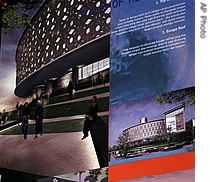2007年VOA标准英语-Tsunami Museum Sparks Debate in Indonesia(在线收听)
Jakarta
27 August 2007
Indonesia has picked an architect to design a museum in Aceh province in memory of the close to 170,000 people who died there during the 2004 Indian Ocean tsunami. But as Chad Bouchard reports from Jakarta, the project is not without controversy.

This poster displays the winning design of tsunami museum by architect Ridwan Kamil in Banda Aceh, Indonesia, 21 Aug 2007
The more than $7.4 million museum project in Banda Aceh will mark one of the most devastating natural disasters of modern times.
Aceh province was decimated nearly three years ago when an undersea earthquake - registering nine on the Richter scale - pushed towering waves onto its shores. The giant tsunami touched a dozen nations ringing the Indian Ocean - but Indonesia suffered the most casualties with 170,000 people dead and missing.
Adamy Aulina, assistant manager for public facilities and building at the Aceh-Nias Rehabilitation and Reconstruction Agency, says she hopes the museum will help survivors heal.
"Aceh Tsunami Museum is a symbol. Respecting the victims and spirit of the survivors," she said. "It would be nice if Acehnese people were proud with the building. It facilitates for people who want to remind their family, friends, or colleagues who died because of the tsunami."
But the museum has its critics who are concerned the project comes too soon after the disaster, and could draw resources away from thousands of people who are still battling to rebuild their lives.
Aceh Heritage Community Foundation co-founder, Yeyen Rahmayati, says a less expensive commemoration would be more appropriate.
"The idea is good, but I think the timing is not right at the moment because there are many tsunami survivors that still need a house, job and something like that," said Rahmayati.
Another issue is the building's location. Museum planners selected a site high on a hill in the middle of Banda Aceh, where hundreds of residents scrambled to escape the waves. But Rahmayati says that hill has historic significance.
"The location is very strategic in the heart of the city center," said Rahmayati. "There was a colonial heritage used as a railway station office, and they already demolished that building, they plan to demolish another building next to the first building, so there will be two heritage buildings demolished to build the tsunami museum, and for me it's an irony, I think."
Reconstruction officials say one of the historic buildings at the site was damaged beyond repair. But, in response to concerns, the museum committee is discussing ways to incorporate remaining structures into the museum design.
The building will be raised on stilts, using an element of traditional Acehnese houses.
Ridwan Kamil, the architect who won a contest to design the museum, says the elevated structure will also incorporate an evacuation center in case of another disaster.
"That escape hill in the future can be used for an emergency situation, in case there is a flood of tsunami people can use that hill as an escape space," he said.
Kamil adds that he wanted to create a structure that would serve as more than a storage place for artifacts or exhibits.
"For me, the tsunami museum has to reflect also the psychology that people went through during these terrible times," he said.
Kamil says the entrance to the museum, called the tsunami passage, is designed to evoke cathartic emotions for survivors and visitors.
"It's a very tight corridor but very high walls with a waterfall from the left and the right, so people walk through the first space to experience how desperate the victims of the tsunami," he added. "The sound of the water will remind them of the situation."
The names of Acehnese who died in the tsunami will be inscribed in the atrium. The museum will also feature a scientific exhibition on earthquakes and tsunamis, with a before-and-after display demonstrating changes to Aceh's coastline.
Adamy Aulina, with the Aceh-Nias Rehabilitation and Reconstruction Agency, says the building signals a transition in the community's recovery, from focusing on immediate needs to exploring hopes for the future.
"It's also a message. We have to learn from the past," she said. "Well we can learn also what is a tsunami, how we can avoid it. That we can respect and learn nature, yeah? Because with that I hope we can make a better environment and a better life."
Museum officials plan to begin construction on the museum by the end of the year, and hope to have it completed for inauguration on the fourth anniversary of the disaster in December 2008.